alan little’s weblog archive for march 2006
a picture a week (6)
25th March 2006 permanent link
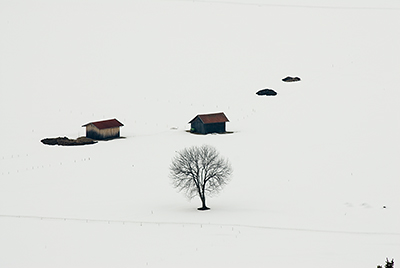
from a castle window
Photos of Mad King Ludwig of Bavaria’s castle at Neuschwanstein are an appalling tourist cliché and could not therefore possibly qualify for A Photo A Week. Photos of the view from Neuschwanstein are ok though.
It’s astonishing what modern cameras and lenses are capable of. The tree in that picture is well over half a mile away. Here’s what it looks like in the full size image (unsharpened on the left, and on the right with Photoshop Smart Sharpening applied):
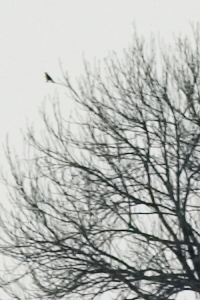

Those fence posts underneath the tree that you can barely see? At 100% you can clearly see the wire:
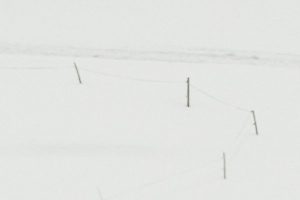
Holy Shit. That wire, remember, is well over half a mile away.
And this with the Nikon gear I can afford, which is very good but not quite the absolute best: a D200 with the 180mm f2.8 lens. A similar but truly state of the art setup – the D2X with the 200mm f2 – might produce just-about-perceptibly better results, but at over four times the price I’d be well into diminishing returns for the extra money.
related entries: Photography
a picture a week (5)
13th March 2006 permanent link
yoga class – learning to fall
Digital cameras – good digital SLRs at any rate – beat film hands down for taking pictures in the dark on any practical measure of resolution, tolerable grain/noise, ability to check that you’re getting exposure right in tricky lighting, etc., etc. They still don’t come close to fast black & white film – in this case Kodak TMax 3200 – for beauty.
related entries: Photography
the peacock’s tale
12th March 2006 permanent link
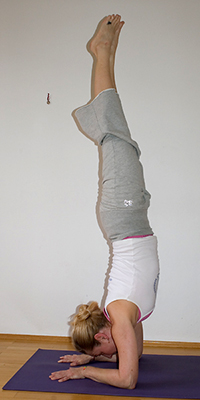
Bettina Anner demonstrates pincha mayurasana.
Pincha Mayurasana, the “feather of the peacock” position, is an elegant looking and quite difficult yoga posture in which you are balancing on your forearms instead of just on your hands. It’s a bit ahead of where I’m “supposed” to be in the ashtanga intermediate series but, like a lot of ashtangis, I do play around from time to time with asanas that are a bit more advanced than what I “should” be doing. Right now I have decided to do more than dabble with pincha mayurasana, because it requires a lot of shoulder mobility. One of my biggest physical challenges in yoga is that I have very tight shoulders from rock climbing and years of working hunched over desks (or, as I am now, sitting in half lotus on the floor hunched over my laptop). Pincha mayurasana should help.
I have always found it a daunting posture. Learning any upside down balancing posture almost inevitably involves a certain amount of falling over, and the further your head is from the floor the scarier that is. I learned to tuck my head and roll out of headstand years ago, but I always assumed it would be a lot more difficult and scary to do it from a position where my head wasn’t already on the floor. Not so, as it turns out, but for a long time I was put off by remembering my mate L learning pincha mayurasana in Mysore. (I will not name L in full here, on the offchance that he might not like his yoga students reading about his former foibles and failings). Every morning for what seemed like weeks, L would kick and flail his feet up into pincha mayurasana only to crash down, still kicking and flailing, onto the mat of the woman opposite, usually landing round about where her head was. As the days went by the poor woman started to look more and more nervous (quite understandably) as the moment for L’s attempt at pincha mayurasana drew near.
However, I have discovered that it actually isn't all that hard after all. Here’s how you learn pincha mayurasana in two easy steps:
- Mess about with it sporadically for a long time, going up with your feet against a wall so you can’t fall over
- Spend half an hour one afternoon practicing kicking up, tucking your head and doing a forward roll out of the position. This turns out not to hurt at all on the nice thick new yoga mat my wife got me for Christmas.
- Now that you’re not afraid any more, get it in a week.
Step (1) is unnecessary.
I realise now that this is another thing I could have learnt years ago if only I’d been paying attention. At a workshop I went to once – admittedly in a session where I was taking photographs and not doing the class – the teacher had everybody practice the tuck and roll thing. The main thing that struck me at the time was that two of the students – my teacher and my wife’s teacher – were persistently doing it wrong. They were both so happy and comfortable in the position they looked like they couldn’t imagine why anybody would want to fall over from it; when they finally were persuaded to come down they had to be told off for elegantly arching over into backbends and placing their feet lightly on the floor instead of falling.
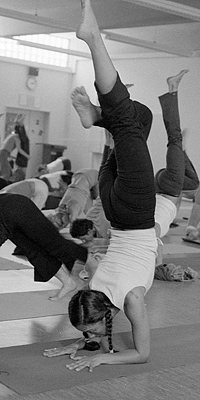
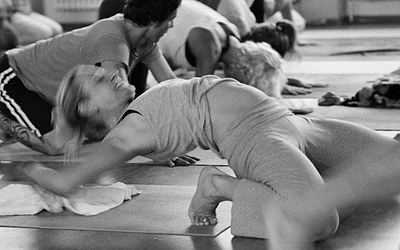
(Does this count as A Photo A Week? We’ll see)
That Disclaimer Again: taking advice about how to do difficult yoga asanas from random strangers on the internet may not be the wisest thing you could possibly do.
related entries: Yoga
yegge on yoga
10th March 2006 permanent link
[people] prefer their current, very real pain to some imagined possibility of a different kind of pain.
Steve Yegge may not have realised that he was coming up with a piece of universal and profound human wisdom in an essay about (the programming languages) Scheme and Java. Or perhaps I underestimate him.
Be thine own palace, or the world's thy jail.
Nobel prizewinning economist Amartya Sen (whose book The Argumentative Indian is high on my reading list) may well not have had yoga in mind either when he quoted John Donne in a review of a book about development economics, but it’s an admirable summary of what yoga is all about nevertheless.
related entries: Yoga
yegge on programming
10th March 2006 permanent link
Everybody (ok, Bill de HÓra and Tim Bray) is suddenly linking to Steve Yegge’s excellent series of essays on programming, why and how as currently practiced it is grotesquely inadequate for the challenges facing large-scale systems development, and how few people are actually thinking seriously about realistic ways of making it better. Bill thinks he could be “the next Greenspun|Spolsky|Graham”, and could be right, although he seems rather less full of himself than Greenspun or Graham – which is a good thing in itself, but also handicap in rising to fame’n’stardom. [UPDATE: Steve’s currrent blog]
Tour de Babel, the essay Bill links to, is one of the better comparative programming languages essays I’ve ever read, and there’s lots of other good stuff there too about just how primitive the state of our art really still is.
Full disclosure: I make my living managing a team that develops a large suite of software that does [useful things] for [several] million customers of a large telco, at a yearly cost of [somewhat fewer] million euros. (Hey, well under a buck per year per customer. I never thought of it that way before – what excellent value we are!) Anybody who thought that what language the whole lot is written in – mostly Java, as it happens, with odd bits of C++ here and there – is even on my list of Things To Worry About would be sorely mistaken. I’m far more taken up with guessing what marketing might want to do next year, and trying to design this year’s four releases in ways don’t make (a reasonable guess at) next year’s requirements impossibly expensive.
I still enjoy writing code in my spare time, although it’s several years since anybody last gave me money for doing so.
Python is currently the language in which I can sit and type working code without having to worry aobut syntax or reference manuals. My previous experience ranges from the sublime (Smalltalk) to the ridiculous (Cobol), via points in between including C, perl, most major commercial SQL dialects, bits of Visual Basic and a quickly-reached decision that C++ wasn’t going to be worth all the hassle and pain. I’ve never made my living as full time Java developer, but I’ve done enough to know I’m glad I don’t have to. In my moments of python frustration I find ruby the language quite appealing, but I’m put off by its obvious immaturity as a development environment: the laughably slow XML parser, the attitude of Unicode denial. But Steve may have talked me into having another look at it.
related entries: Programming
speechless
8th March 2006 permanent link
I woke up this morning with a heavy cold, barely able to speak. So since my day at work was pretty much back-to-back meetings, I decided it wasn’t worth it and am at home catching up on errands and chores instead.
Of course, as anybody who has worked in a large corporation knows, there are people who should only be allowed in meetings if they have lost their voices. But I’m not one of them. Nor are you.
a picture a week (4)
5th March 2006 permanent link
An Apologia: my Photo A Week project was supposed to be about digging worthwhile old pictures out of my my slide cupboard. Until such time as it eventually succeeds, my quest to take a great photograph in Munich’s Westpark is nobody’s problem but my own. And snow-covered trees are an appallingly tedious photographic cliché except in the hands of talented photographers (such as the cinematographer who shot the early scenes of The Lion, The Witch And The Wardrobe – Donald McAlpine, says imdb)
Nevertheless: even in Munich, an hour’s drive from the Alps, the heaviest snowfall in a century doesn’t happen very often; and when it does, those slides don’t scan themselves while I’m out sledging with small children. It’s all a question of priorities
So, Ladies and Gentlemen, The Lantern Waste:
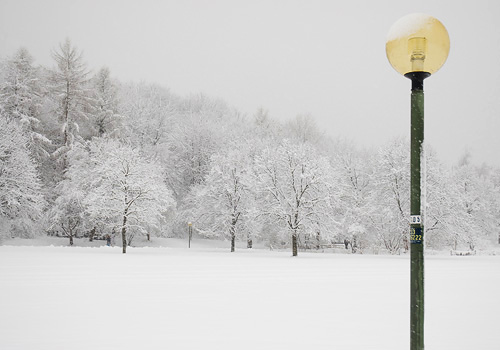
related entries: Photography
the state of the art
4th March 2006 permanent link
what if any are the advantages of the silver halide method of recording images compared to the digital alternative? … The massive change from classical silver halide photography to solid state imagery has been completed by now and the chemical recording of images will become a tiny niche, cared for by a handful of aficionados, as is the case with the vinyl LP record.
… says Leica expert Erwin Puts in an interesting essay that I recently dug out of my to_read list. In it he talks about Leica rangefinder cameras – his great love – their place in the history of photography (the golden age of photojournalism), and the particular style and aesthetic that was built upon their use. The same sort of stuff I talked about my comments on photojournalism in the Second World War, except much better informed and more thought through.
His key point is that different tools and materials encourage different aesthetics, make different things possible in art, and this will continue to be true in the digital photography era. Shooting black & white chemical film in mechanical cameras is an anachronism, no matter how beautifully made the cameras are. There are things you can do, looks you can achieve, with Leicas, available light and black & white film that you can’t with digital – but vice versa too.
I’ve only been taking pictures seriously for ten years and have never set foot in a darkroom. (Actually, a did have a nice little Ricoh rangefinder in my early 20s and enjoyed taking pictures with it, but it got hurt on a climbing trip and didn’t get round to replacing it until many years later. That was a phase of my life when I was lost and confused in many ways.) I’m not a hoary old film photography veteran. But I did learn photography with a 35mm film SLR – my Nikon FM2 which I will never part with even when I do get around to selling, scrapping or giving away all my other film cameras. And even though I shoot nearly all digital these days, I’m still very much an SLR-mindset shooter. Which perhaps makes me a dinosaur from a previous generation too.
I do have a little digicam, a Fuji F10 which I bought because it's supposed to be one of the faster-focusing and generally more responsive small cameras, and quite good for available light photography without flash. Supposedly. I still find it frustratingly slow in the kind of fairly low light indoor situations where I usually want to take snapshots. Its six megapixel picture quality makes reasonable small prints of my son for his grandmothers, but is nowhere near even a previous generation six megapixel SLR like a D70, let alone something more state of the art like the D200. The F10 is better than nothing, but if I were willing to lug my D200 around with me everywhere I would enjoy taking pictures a lot more, and get better pictures.
This is actually a big difference from the film days, and not one that is favourable to digital. A lot of small 35mm film cameras, including the little Yashicas and Olympuses I used to use, were (are) capable in the right circumstances of producing results every bit as good as professional SLRs. They had limitations – fixed lenses, slow autofocus and general lack of control – but the lenses were just as good as SLR lenses, and of course they used exactly the same sensors as their big brothers, in the form of bits of 35mm film. In most of the circumstances where you want to carry a small camera just in case, being theoretically capable of the same image quality as an SLR isn’t particularly relevant, but I did sometimes get some pretty decent pictures with film point’n’shoots.
The problem with small digicams isn’t lens quality. Plenty of them have good lenses. Small good lenses are easier and cheaper to make than big ones, and Fuji’s ability to make excellent lenses is beyond question. But the physics of small batteries and small sensors dictate that autofocus will always be slower, and pixel-for-pixel image quality will be worse. I personally have yet to take a good picture with a small digicam.
I’m not suggesting it can’t be done, though, and that’s the whole point. Just as with the switch from rangefinder to SLR photography that Erwin Puts writes about, there will be people who create marvellous pictures that take advantage of the strengths of small digital cameras, and that will have an aesthetic of their own that is different from the era of 35mm SLR photography. Alex Majoli, who won Photojournalist Of The Year 2004 using Olympus digicams, might be one of those people.
(There are other things too about the new digital world that aren’t improvements – everything has its trade-offs. We’re too dependent now on expensive, fragile, battery-hungry electronic gadgets compared to the days when all the storage and electricity you needed was a bag of film and a tiny little battery for the lightmeter that you had to remember to change every couple of years. But the places where those things are an advantage don’t feature prominently at the moment in my life as a responsible husband-and-father – the days of journeys by bus and motorbike around rural India, and week long hikes in the Arizona desert, are behind me for the time being. Pity. I can see the D200 making a lovely job of red dust-haze Deccan twilight.)
UPDATE: Steve Crandall has a friend who is a professional fashion and ad photographer, who says he is more creative and has more fun with his little pocket digicam. That I am not says more about my personal prejudices and limitations than those of digicams.
related entries: Photography
all text and images © 2003–2008